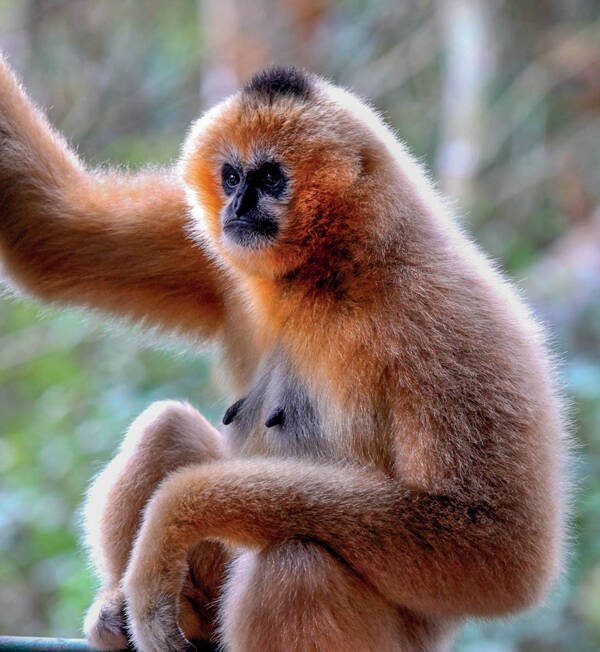Nomascus leucogenys
IUCN
LCBasic Information
Scientific classification
- name:Nomascus leucogenys
- Scientific Name:Nomascus leucogenys,White-cheeked gibbon,Northern White-cheeked Gibbon, White-cheeked Gibbon, Gibbon à favoris blancs du Nord , vượn bạc má, vượn má trắng bắc, vượn đen má trắng,Hylobates le
- Outline:Primates
- Family:Hylobates B.Gibbon
Vital signs
- length:45-62cm
- Weight:5-7kg
- lifetime:28 years and above
Feature
The male's fur is mainly black with a faint silver color, while the female's fur is orange to milky white, with no black hair on the abdomen.
Distribution and Habitat
It is a species endemic to the border area between China, Vietnam and Laos. It is only distributed in Jiangcheng, Jianshui, Mengla and Luchun in Xishuangbanna, Yunnan in China. It is distributed west of Majiang in the Red River Basin in northern Vietnam and east of Mekong River in northern Laos.
Appearance
The legs are short. The palms are longer than the soles of the feet, and the knuckles are long. The body is slender, with broad shoulders and narrow hips. It has long canine teeth. The body hair is long and rough. The male is mainly black, mixed with inconspicuous silver, and there is a patch of white or yellow hair on each side of the cheek from the corner of the mouth to the top of the ear; the female body hair is orange-yellow to milky white, and there is no black hair on the abdomen, which distinguishes it from the black-crested gibbon.
Details
The northern white-cheeked gibbon is a species of primate, family Hylobates. It inhabits tall primary and degraded evergreen and semi-evergreen forests. In northwestern Vietnam and northern Laos, these animals live in a subtropical climate with short and not too cold winters without frost. In Vietnam, the species is found at altitudes between 200-1,000 meters, with the highest record reaching 1,500 meters above sea level, however, individuals were found in 2011, mostly at altitudes above 700 meters due to lowland deforestation. In Laos, the northern white-cheeked gibbon is found at least 1,650 meters above sea level from the Mekong plains to Nam Et-Phou Loei NPA.

The northern white-cheeked gibbon is mainly a frugivorous animal. It mainly feeds on a variety of tropical wild fruits (berries, drupes, nuts, especially banyan fruits), tender leaves, flower buds, tree buds, etc. It also eats insects, small birds and bird eggs. There are about 85 kinds of food, of which plant food accounts for 90.6% of the total food, including fruits (39%), leaves (36%) and flowers (5%). Usually one hand hangs on the branches and the other hand picks food, alternating between the two hands. They forage mostly in the middle and upper parts of tall tree canopies, at a height of about 10-25 meters.
The northern white-cheeked gibbon is the northernmost, smallest, and least abundant species of gibbon in Indochina. In the 1950s and 1960s, there were a large number of northern white-cheeked gibbons in southern Yunnan, with about 130-150 groups and more than 530-620 individuals in Mengla County, Xishuangbanna alone. In the early 1980s, there were about 18 groups and more than 70 individuals (Yang Dehua et al., 1987). Together with the number of Luchun, there may be 80-100 individuals (Ma Shilai, 1988). During the same period, the number of northern white-cheeked gibbons in Mengla area decreased by 86% compared with before the early 1960s. In the late 1980s, the number of northern white-cheeked gibbons in Mengla was less than 40 (Hu Yu et al., 1989), and the northern white-cheeked gibbons in Huanglian Mountain, Lvchun were close to extinction. The number in northern Vietnam was less than 200 (Cao and Pham, 1994), and there may be less than 100 in Laos.

The main reason for the endangerment of the northern white-cheeked gibbon is the destruction of its habitat. In addition to extracting fuelwood and timber from the remaining forest habitat, the species is also subject to deforestation due to agricultural encroachment in lowlands and mountains. To protect this precious animal, China has established the Yunnan Mengla Nature Reserve, which focuses on protecting the northern white-cheeked gibbon.
Listed in China's "National Key Protected Wildlife List" (February 5, 2021) at level one.








